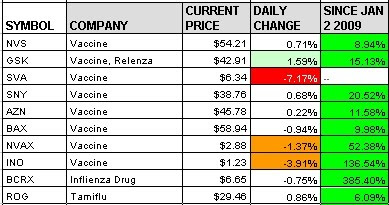The Shocked Investor picked up my latest article on swine flu and the emergence of tamiflu resistance, and connected the development with moves in "flu stocks." I’ll note that the current H1N1 vaccines should still be effective against tamiflu resistant viruses, but the injectible vaccines may not be very effective against viruses with receptor binding domain changes, represented by the D225G marker, or other changes in the 225 position. On another note, Dr. Henry Niman is predicting another wave of infections sometime this winter. Read more here. – Ilene
Tamiflu Resistance and The Fall of H1N1 Drug Companies
Courtesy of The Shocked Investor
We track all H1N1 companies live here. These companies had been up hundreds of percent earlier this year and have taken a beating recently, as we expected (and wrote about). This was the situation in October:
And this is the status today:
(CHIP was sold.) Note the declines since October.
You may receive technical analysis and alerts of these companies sent automatically to you, by entering the symbols in the Technical Trend Analysis Tool. Here is the current ROI:
Coincidentally with the drop of these H1N1 companies has been the news of Tamiflu resistance. Ilene, from Phil’s Stock World, has an update on H1N1, again speaking to Dr. Henry Niman. She discusses several timely topics which directly affect a couple of the companies above.
The Emergence of Tamiflu Resistance
The swine flu virus has been increasing showing changes leading to greater incidences of Tamiflu resistance, but this being downplayed by the CDC and WHO. The CDC recently issued this CDC report:
A total of 29 cases of oseltamivir resistant 2009 influenza A (H1N1) viruses have been identified in the United States since April 2009. In specimens collected since September 1, 2009, 19 cases have been identified in the United States, including three newly identified cases since last week. The proportion of oseltamivir-resistant 2009 H1N1 viruses does not represent the prevalence of oseltamivir-resistant 2009 H1N1 in the U.S. Most cases were tested because drug resistance was suspected. All tested viruses retain their sensitivity to the neuraminidase inhibitor zanamivir. Of the 29 total cases identified, 19 patients had documented exposure to oseltamivir through either treatment or chemoprophylaxis, eight patients are under investigation to determine exposure to oseltamivir, and two patients had no documented oseltamivir exposure. Occasional development of oseltamivir resistance during treatment or prophylaxis is not unexpected. Enhanced surveillance and increased availability of testing performed at CDC are expected to detect additional cases of oseltamivir resistant 2009 influenza A (H1N1) viruses, and such cases will be investigated to assess the spread of resistant strains in the community.
According to Dr. Niman, the CDC and WHO typically use these types of announcements for propaganda. The information is factually correct, but extremely misleading. Most patients give a sample prior to treatment and in most cases CDC or WHO can determine if the H274Y marker was present prior to treatment. However, they don’t even have a category for those who are initially H274Y positive and then get treated, like the Vietnam cluster.
When there is a small population of drug-resistant viruses co-existing with the wild-type, drug-sensitive viruses, exposure to the drug kills off the sensitive population while allowing the resistant viruses to flourish. In cases testing positive for the H274Y marker, the vast majority of patients has been infected with H1N1 virus with the H274Y marker before treatment, or develops H274Y within a few days. This suggests a pre-existing sub-population is being selected. Data withheld by the CDC and WHO would likely reveal this, destroying the "spontaneous generation" theory, which the CDC, WHO and Roche promote. These propaganda pieces are not only designed to hide the true level of H274Y in the absence of Tamiflu treatment, but also hide the fact that "spontaneous" H274Y mutation is a pure fantasy. The emergence of Tamiflu resistance is NOT due to random mutation.
For a more detailed account, read Dr. Niman’s article Tamiflu Resistance Spike in US Raises Transparency Concerns, Recombinomics, December 14, 2009.
For my full article on Swine Flu, click here.




